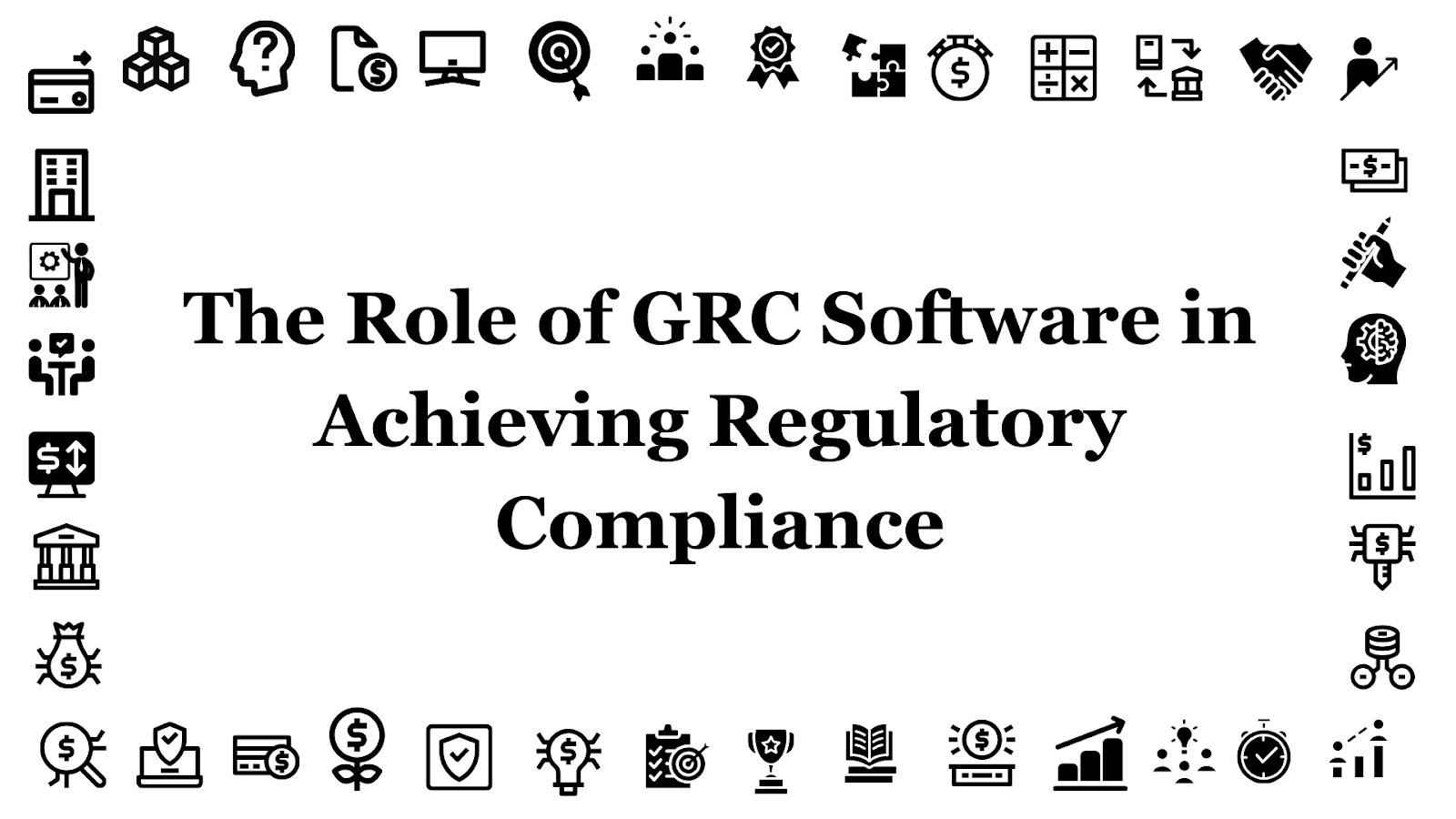The Role of GRC Software in Achieving Regulatory Compliance

In a world where regulations are constantly evolving, businesses often find themselves navigating complex compliance requirements. The acronym GRC, which stands for Governance, Risk, and Compliance, has become a beacon of hope for organizations striving to meet these challenges head-on. In this article, we’ll delve into the crucial role of GRC software in achieving regulatory compliance, making the complex seem simple.
Understanding the GRC Platform
The GRC platform is like a conductor for your business compliance activities. They bring together governance, risk management, and compliance tasks into one unified system.
Key features include:
- Central storage of regulations, policies, controls, and compliance documents
- Managing audits, findings, and reporting
- Assessing and scoring operational, financial, and compliance risks
- Tracking compliance incidents and breaches
By consolidating data and processes, GRC software provides complete visibility across compliance. It breaks down departmental silos so everyone can work together seamlessly.
The Significance of GRC Software
Navigating regulatory compliance can often feel like sailing through uncharted waters. GRC software acts as a compass, providing clear direction for navigating the complex seas of regulations. It centralizes information, making it easier to interpret and implement regulatory requirements seamlessly.
With regulations continuously changing across industries, keeping up with compliance obligations has become an uphill battle. Just looking at financial services, banks face a barrage of legislation ranging from Dodd-Frank, Basel III, AML, and KYC to consumer protection laws. Pharma companies deal with strict FDA regulations and trial protocols. For tech firms, privacy laws like GDPR present new hurdles.
GRC software helps simplify this complex web of regulations. Centralized regulatory content libraries store and track obligations from global regulations and standards. Specialized tracking ensures compliance with every requirement, deadline, and deliverable. Collaborative workflows help implement controls enterprise-wide.
Streamlining Processes for Productivity
GRC software is your digital assistant, automating repetitive tasks and reducing the risk of human error. This not only enhances efficiency but also allows your team to focus on strategic initiatives instead of drowning in paperwork. It’s like upgrading from a rowboat to a high-speed yacht.
As the volume of compliance data continues to grow exponentially, manual processes become inadequate. Disparate spreadsheets and documents lead to errors, duplications, and lack of transparency. Simply managing the deluge of information consumes time and resources.
GRC suites automate redundant activities through features like:
- Automated policy mapping and testing
- Questionnaire-based controls assessment
- Scheduled report generation
- Multi-level review workflows
- Automatic policy attestations
- Real-time dashboards
By mimicking manual processes digitally, they boost productivity, optimize quality control, and promote informed decision-making. The intuitive interface allows non-technical users to manage end-to-end workflows with minimal training.
Your compliance team can dedicate their expertise to high-value responsibilities like risk analysis, training, and advising the business. They evolve from reactive doers to proactive advisors.
Choosing the Right GRC Platform
Choosing a GRC platform is like selecting the right tool for the job.. Consider the unique needs and nuances of your business to ensure a seamless fit. A one-size-fits-all approach won’t suffice, just as a wrench won’t solve every problem in your toolkit.
With the influx of solutions in the market, filtering through the noise can prove challenging. Keep the following factors in mind during your selection process:
- Regulations: Rank software that specializes in your industry regulations e.g. healthcare, finance.
- Deployment Model: SaaS options provide faster implementation while on-premise allows for customization.
- Budget: Opt for packages aligned with your spending flexibility and scalability needs.
- Features: Ensure core modules like policy management, risk assessment, and incident management are included.
- Scalability: Pick solutions that can seamlessly adapt as your programs expand.
- Usability: Simple, intuitive interfaces reduce training time and ensure quick user adoption.
By aligning GRC capabilities with your organizational needs, you pave the path for long-term success. Don’t settle for systems that check the bareest boxes. Look for platforms positioned to grow and evolve as your organization matures.
The Road to Compliance Success
Implementing GRC software is like assembling a puzzle; each piece serves a specific purpose. Plan meticulously, involve all stakeholders, and communicate effectively to ensure a successful transition. It’s not just about adopting a tool; it’s about transforming your entire compliance landscape.
Key steps to follow include:
- Performing a compliance program assessment of current gaps. This highlights where the GRC tool can provide the most impact.
- Creating a detailed project plan with realistic timelines based on vendor recommendations.
- Forming a cross-functional team including reps from compliance, IT, legal, and business units to provide a holistic perspective.
- Conducting training across all user groups to ensure skill in utilizing the system.
- Establishing ongoing forums for feedback, enhancement requests, and iteration of the platform.
By institutionalizing GRC as a company-wide initiative, you generate momentum that carries your compliance program to the next level. Maintain realistic expectations, celebrate small wins, and keep evolving both technology and your workforce.
Overcoming Challenges with GRC Software
Every journey has its hurdles. GRC software equips you with the tools to overcome challenges, whether it’s adapting to new regulations or addressing internal resistance. Think of it as a shield that protects your organization from compliance pitfalls.
Common obstacles faced when implementing and utilizing GRC suites include:
- Data Inaccuracies: Garbage in, garbage out. Faulty data leads to incorrect reporting and metrics. Instituting data validation controls and system integrations helps safeguard integrity.
- Lack of Buy-In: Compliance is often viewed as a roadblock. Get leadership and employees excited by showing how GRC improves efficiency and reduces risk exposure.
- Tool Fatigue: Employees already inundated with many systems may resist adopting new software. Make training and onboarding engaging and emphasize how GRC consolidates systems.
- Customization Constraints: Strike a balance between leveraging out-of-the-box features and accommodating unique needs. Focus on must-have customizations through change management processes.
- Reporting Deficiencies: Collaborate cross-functionally to determine essential report templates and parameters. Iteratively refine reporting as needs evolve.
A proactive, collaborative approach to mitigating these roadblocks is key to GRC’s success. Maintain perspective by focusing on long-term gains over short-term hurdles.
Conclusion
In conclusion, GRC software plays a pivotal role in achieving regulatory compliance. It transforms the daunting task of navigating regulations into a manageable, strategic try. Remember, it’s not just about ticking boxes; it’s about fostering a culture of compliance within your organization. It steers your organization safely along the winding road of ever-evolving regulations.
Leverage its automation and risk management capabilities to gain a strategic advantage So let GRC software conduct the compliance orchestra at your enterprise. Use GRC as the compass and roadmap to guide your organization’s compliance journey.
Key Takeaways
- GRC platforms centralize and integrate activities related to governance, risk, and compliance.
- They provide a holistic, transparent view of the compliance landscape.
- Core features include policy management, audit management, risk management, and incident management.
- GRC software harmonizes compliance efforts across the organization.
- It streamlines compliance processes through workflow automation.
- GRC breaks down departmental silos for unified transparency.
FAQs
- What does GRC stand for?
GRC stands for Governance, Risk, and Compliance. - Does GRC software replace manual compliance processes?
GRC software augments and streamlines manual processes through workflow automation; however, it does not eliminate the need for human input and oversight. - Which departments within an organization use GRC platforms?
Typical users include Compliance, Audit, Legal, IT, Finance, Risk Management, and business unit leaders. - How can GRC software help with regulatory compliance?
GRC centralizes all regulations within a single system. It helps map controls, manage obligations, and provides audit trails to evidence compliance.
Working with a personal trainer offers long-term benefits that go beyond losing weight. They help you develop healthy habits and a sustainable lifestyle. Discover the long-term benefits of having a weight loss personal trainer Winter Park FL and how they can improve your overall health.
Ensure a smooth journey with taxi uber service’s advance booking facility. Whether for business or leisure, our Uber-like service guarantees timely and comfortable rides. Book in advance and focus on your trip, not your transport.
Our taxi uber provides an advance booking facility, making it easy to plan your transportation. Perfect for business or private travel, enjoy the reliability and comfort of an Uber-like experience. Book your ride in advance today.
I discovered your blog site on google and examine a number of of your early posts. Continue to maintain up the superb operate. I simply extra up your RSS feed to my MSN News Reader. In search of forward to reading more from you later on!… https://bahisbey-canli-bahis.com
Additionally, it doesn’t matter how extremely you should be complete with treating a very platform, gradually you’ll discover an instance the places you should want to do a number instruct care; and as a consequence influenced by your real age but also bodybuilding, therfore the inches of one’s caravan it could be a awfully excessive pastime. motor moversFitness Gear



